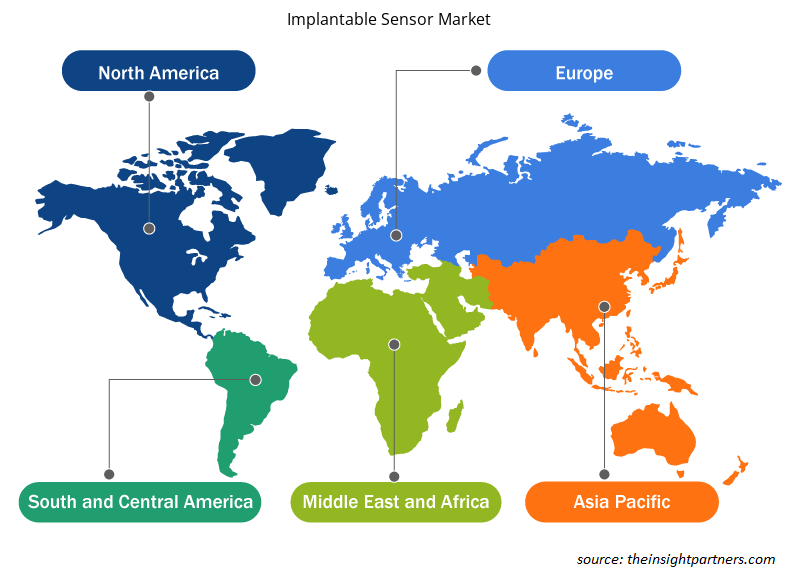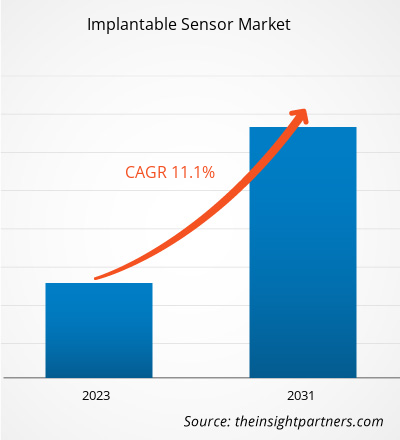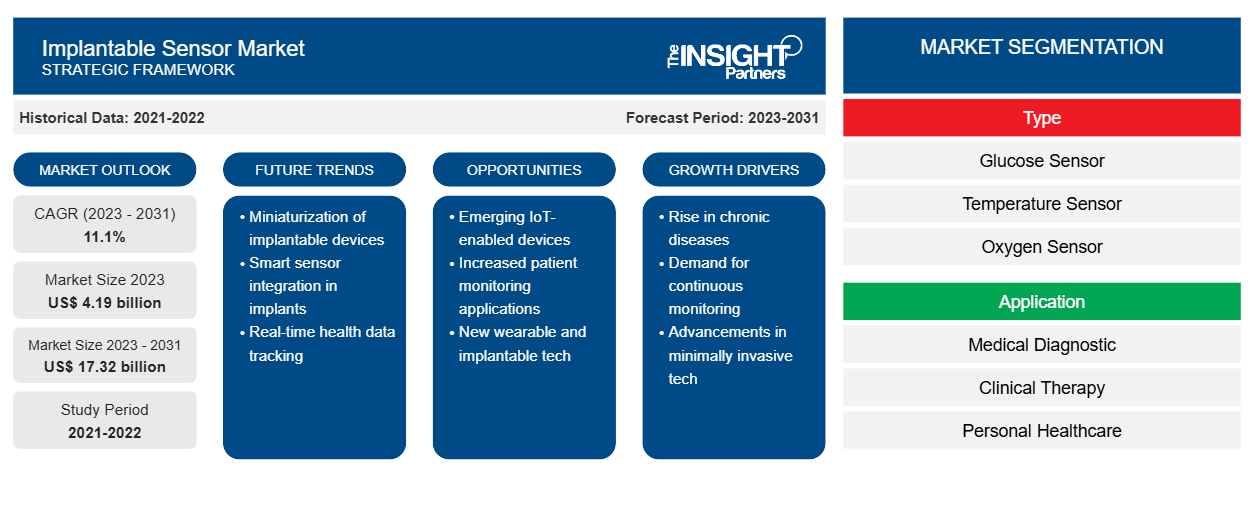Das Marktvolumen für implantierbare Sensoren wurde im Jahr 2023 auf 4,19 Milliarden US-Dollar geschätzt und soll bis 2031 17,32 Milliarden US-Dollar erreichen.
Bis 2031 wird mit einer durchschnittlichen jährlichen Wachstumsrate (CAGR) von 11,1 % gerechnet. Die Entwicklung neuartiger Sprachtherapien, alternativer Kommunikationsmethoden, vermehrter Hörscreenings bei Neugeborenen und der Einsatz künstlicher Intelligenz in Sprachtherapien bleiben voraussichtlich die wichtigsten Trends auf dem Markt für implantierbare Sensoren.
Marktanalyse für implantierbare Sensoren
Implantierbare Sensoren sind kleine medizinische Geräte, die in den Körper eingesetzt werden, um verschiedene physiologische Parameter wie Temperatur, Druck, Glukosespiegel oder Medikamentenkonzentration zu überwachen. Solche Produkte haben in der Gesundheitsbranche enorme Aufmerksamkeit erhalten. Das Gerät kann Gesundheitsspezialisten Echtzeitdaten liefern, um chronische Erkrankungen besser behandeln oder Operationen vor und nach Operationen überwachen zu können. Die zunehmende Verbreitung chronischer Erkrankungen dürfte die Entwicklung neuer Produkte begünstigen und den Markt für implantierbare Sensoren ankurbeln.
Marktübersicht für implantierbare Sensoren
Das Wachstum des Marktes wird auf einige wichtige treibende Faktoren zurückgeführt, wie die zunehmende Verbreitung chronischer Krankheiten und die zunehmende Nutzung mobiler Gesundheitstechnologien. Die geringe Akzeptanz in Schwellenländern ist jedoch ein wichtiger Faktor, der das Marktwachstum behindert. Der globale Markt für implantierbare Sensoren ist nach Regionen unterteilt in Nordamerika, Europa, Asien-Pazifik, Naher Osten und Afrika sowie Süd- und Mittelamerika. In Nordamerika sind die USA der größte Markt für implantierbare Sensoren. Das Wachstum der Region wird auf die Präsenz wichtiger Marktteilnehmer und wachsende Produktentwicklungen zurückgeführt. Darüber hinaus wird erwartet, dass kontinuierliche Produktentwicklungen das Wachstum des Marktes für implantierbare Sensoren in Nordamerika weiter ankurbeln. Die Region Asien-Pazifik wird voraussichtlich das schnellste Wachstum des Marktes für implantierbare Sensoren aufweisen.
Passen Sie diesen Bericht Ihren Anforderungen an
Sie erhalten kostenlose Anpassungen an jedem Bericht, einschließlich Teilen dieses Berichts oder einer Analyse auf Länderebene, eines Excel-Datenpakets sowie tolle Angebote und Rabatte für Start-ups und Universitäten.
-
Holen Sie sich die wichtigsten Markttrends aus diesem Bericht.Dieses KOSTENLOSE Beispiel umfasst eine Datenanalyse von Markttrends bis hin zu Schätzungen und Prognosen.
Treiber und Chancen auf dem Markt für implantierbare Sensoren
Zunehmende Nutzung mobiler Gesundheitstechnologien begünstigt den Markt
Die zunehmende Verbreitung mobiler Gesundheitstechnologien revolutioniert die Gesundheitsversorgung, indem sie bequemen Zugang zu medizinischen Informationen, Überwachungs- und Kommunikationstools über Smartphones, tragbare medizinische Geräte und andere Geräte bietet. Der Trend befähigt Einzelpersonen, die Verantwortung für ihre Gesundheit zu übernehmen, erleichtert die Fernüberwachung von Patienten, verbessert den Zugang zu Gesundheitsdiensten und verbessert das allgemeine Patientenerlebnis. Chronische Erkrankungen wie Diabetes, Bluthochdruck und Arrhythmieerkennung sind die Haupttreiber des weltweiten Marktanteils implantierbarer Sensoren.
Staatliche Förderung medizinischer Technologien – eine Chance inMarkt für implantierbare Sensoren
Investitionen in medizinische Forschungs- und Entwicklungsaktivitäten nehmen weltweit zu. Laut dem Bericht „US Investments in Medical and Health Research and Development 2016–2020“ wurden die Investitionen in den USA für medizinische und gesundheitliche Forschung und Entwicklung von 2016 bis 2020 um 48,5 Milliarden US-Dollar oder 42 % erhöht, und die staatlichen Investitionen stiegen von 2016 bis 2020 um 21,4 Milliarden US-Dollar oder 53,5 %. Auch die Investitionen in Medizintechnik stiegen von 2016 bis 2020 um 36,49 %. Die staatliche Unterstützung bei der Weiterentwicklung der Medizintechnik dürfte sich daher positiv auf den Markt für implantierbare Sensoren auswirken, da sie eine Chance für Hersteller medizinischer Geräte darstellt.
Segmentierungsanalyse des Marktberichts für implantierbare Sensoren
Wichtige Segmente, die zur Ableitung der Marktanalyse für implantierbare Sensoren beigetragen haben, sind Typ, Anwendung und Endbenutzer.
- Nach Typ ist der Markt für implantierbare Sensoren in Glukosesensoren, Temperatursensoren , Sauerstoffsensoren, Drucksensoren und andere unterteilt. Das Softwaresegment hatte 2023 einen größeren Marktanteil. Das Glukosesensorsegment hatte 2023 den größten Marktanteil, während das Sauerstoffsensorsegment im Prognosezeitraum voraussichtlich die höchste durchschnittliche jährliche Wachstumsrate auf dem Markt verzeichnen wird.
- Nach Anwendung ist der Markt in medizinische Diagnostik, klinische Therapie, persönliche Gesundheitspflege und Bildgebung segmentiert. Das Segment der medizinischen Diagnostik hatte 2023 den größten Marktanteil; jedoch wird erwartet, dass das Segment der persönlichen Gesundheitspflege zwischen 2024 und 2031 die höchste durchschnittliche jährliche Wachstumsrate (CAGR) auf dem Markt verzeichnet.
- In Bezug auf die Endverbraucher ist der Markt in Krankenhäuser, Kliniken und Diagnosezentren unterteilt. Das Krankenhaussegment dominierte den Markt im Jahr 2023 und wird im Prognosezeitraum voraussichtlich die höchste durchschnittliche jährliche Wachstumsrate (CAGR) auf dem Markt verzeichnen.
Implantierbare Sensoren Marktanteilsanalyse nach Geografie
Der geografische Umfang des Marktberichts für implantierbare Sensoren ist hauptsächlich in fünf Regionen unterteilt: Nordamerika, Asien-Pazifik, Europa, Naher Osten und Afrika sowie Südamerika/Süd- und Mittelamerika.
Nordamerika dominiert den Markt für implantierbare Sensoren. Laut der American Diabetes Association werden im Jahr 2021 fast 38,4 Millionen Amerikaner oder ca. 11,6 % der Bevölkerung an Diabetes leiden, wobei die ältere Bevölkerung oder Personen ab 65 Jahren den größten Anteil ausmachen. Aufgrund der steigenden Zahl von Diabeteserkrankungen in der Region hatte Nordamerika im Jahr 2022 den größten Anteil. Die Neigung zu technisch fortschrittlichen Produkten und die Präsenz globaler Marktteilnehmer sind Faktoren, die zur Dominanz des nordamerikanischen Marktes für implantierbare Sensoren beitragen. Der asiatisch-pazifische Raum wird in den kommenden Jahren voraussichtlich mit der höchsten durchschnittlichen jährlichen Wachstumsrate wachsen.
Regionale Einblicke in den Markt für implantierbare Sensoren
Die regionalen Trends und Faktoren, die den Markt für implantierbare Sensoren im Prognosezeitraum beeinflussen, wurden von den Analysten von Insight Partners ausführlich erläutert. In diesem Abschnitt werden auch die Marktsegmente und die Geografie für implantierbare Sensoren in Nordamerika, Europa, im asiatisch-pazifischen Raum, im Nahen Osten und Afrika sowie in Süd- und Mittelamerika erörtert.

- Erhalten Sie regionale Daten zum Markt für implantierbare Sensoren
Umfang des Marktberichts über implantierbare Sensoren
| Berichtsattribut | Details |
|---|---|
| Marktgröße im Jahr 2023 | 4,19 Milliarden US-Dollar |
| Marktgröße bis 2031 | 17,32 Milliarden US-Dollar |
| Globale CAGR (2023 - 2031) | 11,1 % |
| Historische Daten | 2021-2022 |
| Prognosezeitraum | 2023–2031 |
| Abgedeckte Segmente |
Nach Typ
|
| Abgedeckte Regionen und Länder |
Nordamerika
|
| Marktführer und wichtige Unternehmensprofile |
|
Dichte der Marktteilnehmer für implantierbare Sensoren: Die Auswirkungen auf die Geschäftsdynamik verstehen
Der Markt für implantierbare Sensoren wächst rasant. Dies wird durch die steigende Nachfrage der Endnutzer aufgrund von Faktoren wie sich entwickelnden Verbraucherpräferenzen, technologischen Fortschritten und einem größeren Bewusstsein für die Vorteile des Produkts vorangetrieben. Mit der steigenden Nachfrage erweitern Unternehmen ihr Angebot, entwickeln Innovationen, um die Bedürfnisse der Verbraucher zu erfüllen, und nutzen neue Trends, was das Marktwachstum weiter ankurbelt.
Die Marktteilnehmerdichte bezieht sich auf die Verteilung von Firmen oder Unternehmen, die in einem bestimmten Markt oder einer bestimmten Branche tätig sind. Sie gibt an, wie viele Wettbewerber (Marktteilnehmer) in einem bestimmten Marktraum im Verhältnis zu seiner Größe oder seinem gesamten Marktwert präsent sind.
Die wichtigsten Unternehmen auf dem Markt für implantierbare Sensoren sind:
- Analog Devices, Inc.
- DEXCOM, INC.
- Glusense Ltd.
- Honeywell International Inc.
- Medtronic
- NXP SEMICONDUCTORS NV
Haftungsausschluss : Die oben aufgeführten Unternehmen sind nicht in einer bestimmten Reihenfolge aufgeführt.

- Überblick über die wichtigsten Akteure auf dem Markt für implantierbare Sensoren
Neuigkeiten und aktuelle Entwicklungen zum Markt für implantierbare Sensoren
Der Markt für implantierbare Sensoren wird durch die Erhebung qualitativer und quantitativer Daten nach Primär- und Sekundärforschung bewertet, die wichtige Unternehmensveröffentlichungen, Verbandsdaten und Datenbanken umfasst. Im Folgenden finden Sie eine Liste der Entwicklungen auf dem Markt für implantierbare Sensoren und Strategien:
- Im Dezember 2023 implantierte Medstar als erstes Unternehmen weltweit das Cordella-Sensorimplantat für fortgeschrittene Herzinsuffizienz. Der Sensor sendet den Lungenarteriendruck des Patienten über einen drahtlosen mikroelektromechanischen Sensor aus der Ferne an das Ärzteteam. Mit diesen Echtzeitdaten können Ärzte Medikamente und Therapien proaktiv anpassen, um Krankenhausaufenthalte wegen Herzinsuffizienz zu reduzieren. (Quelle: MedStar Health, Pressemitteilung, 2024)
- Im Februar 2022 gab Ascensia Diabetes Care, ein globales Diabetesunternehmen, bekannt, dass sein Partner Senseonics Holdings, Inc. von der US-amerikanischen Food and Drug Administration (FDA) die Zulassung für das Eversense® E3 Continuous Glucose Monitoring (CGM)-System der nächsten Generation erhalten hat. Ascensia plant, den Eversense E3-Sensor, der bis zu 6 Monate lang verwendet werden kann, Patienten in den USA zur Verfügung zu stellen (Quelle: Ascensia Diabetes Care Holdings AG., Senseonics, Inc. Pressemitteilung/Unternehmenswebsite/Newsletter, 2024)
Marktbericht zu implantierbaren Sensoren – Umfang und Ergebnisse
Der Bericht „Marktgröße und Prognose für implantierbare Sensoren (2024–2031)“ bietet eine detaillierte Analyse des Marktes, die die folgenden Bereiche abdeckt:
- Marktgröße und Prognose auf globaler, regionaler und Länderebene für alle wichtigen Marktsegmente, die im Rahmen des Projekts abgedeckt sind
- Marktdynamik wie Treiber, Beschränkungen und wichtige Chancen
- Wichtige Zukunftstrends
- Detaillierte PEST/Porters Five Forces- und SWOT-Analyse
- Globale und regionale Marktanalyse mit wichtigen Markttrends, wichtigen Akteuren, Vorschriften und aktuellen Marktentwicklungen
- Branchenlandschaft und Wettbewerbsanalyse, einschließlich Marktkonzentration, Heatmap-Analyse, prominenten Akteuren und aktuellen Entwicklungen
- Detaillierte Firmenprofile
- Historische Analyse (2 Jahre), Basisjahr, Prognose (7 Jahre) mit CAGR
- PEST- und SWOT-Analyse
- Marktgröße Wert/Volumen – Global, Regional, Land
- Branchen- und Wettbewerbslandschaft
- Excel-Datensatz
Aktuelle Berichte
Verwandte Berichte
Erfahrungsberichte
Grund zum Kauf
- Fundierte Entscheidungsfindung
- Marktdynamik verstehen
- Wettbewerbsanalyse
- Kundeneinblicke
- Marktprognosen
- Risikominimierung
- Strategische Planung
- Investitionsbegründung
- Identifizierung neuer Märkte
- Verbesserung von Marketingstrategien
- Steigerung der Betriebseffizienz
- Anpassung an regulatorische Trends























 Kostenlose Probe anfordern für - Markt für implantierbare Sensoren
Kostenlose Probe anfordern für - Markt für implantierbare Sensoren